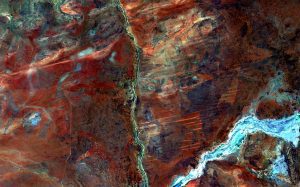
The center of this Sentinel-2A image shows Wolfe Creek Crater, which is about 875 meters in diameter. (Credit: Contains modified Copernicus Sentinel data (2016), processed by ESA)
The European Space Agency (ESA) Copernicus Sentinel-2A satellite captured this image over the northern part of Western Australia in the Wolfe Creek Crater National Park. The area is close to the edge of the Great Sandy Desert, the country's second-largest desert.
The central Wolfe Creek Crater is a remnant of a meteorite crash approximately 300,000 years ago. The crater's name comes from its vicinity to the nearby Wolfe Creek, after being spotted during aerial surveys in the 1940s. The crater has long been known to the Aboriginal people as Kandimalal and is believed to be the site where a rainbow-colored snake emerged from the ground to create the nearby creek.
Although roads appear as straight lines cutting across the landscape, other lines appear brighter, particularly in the image's lower-central area. These are sand ridges shaped by east-west prevailing winds, and their brightness comes from a difference in vegetation, or lack of vegetation, detected by Sentinel-2's multispectral imager.

